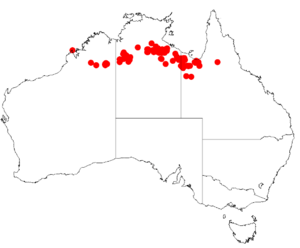Acacia calligera facts for kids
Quick facts for kids Acacia calligera |
|
|---|---|
| Scientific classification | |
| Genus: |
Acacia
|
| Species: |
calligera
|
 |
|
| Occurrence data from AVH | |
Acacia calligera is a type of bush found in northern Australia. It belongs to a large group of plants called Acacia, also known as wattles.
What Does the Acacia Calligera Look Like?
This bush usually grows to be about 0.5 to 1.5 meters (about 1.5 to 5 feet) tall. It has a wide, spreading shape, sometimes even flat on top. Its branches are smooth and shiny, with clear ridges.
Like most Acacia plants, it doesn't have true leaves. Instead, it has special flattened stems called phyllodes. These phyllodes are usually oval or oblong. They can be straight or slightly curved at the tips.
The phyllodes are evergreen and have a grey-green color. They are about 0.3 to 2 centimeters long and 2 to 8 millimeters wide. Each phyllode has five to seven yellowish lines, called nerves, along its edges. The middle nerve is usually stronger than the others.
This plant blooms between February and August. During this time, it produces bright yellow flowers.
Where Does the Acacia Calligera Grow?
Acacia calligera grows in a few small areas across northern Australia. You can find it in the Kimberley region of Western Australia. It also grows through the Barkly Tableland and Katherine Region in the Northern Territory. Its range extends into the Normanton area of Queensland.
This bush often grows on flat plains, ridges, or steep slopes. It prefers red, sandy, or clay soils. These soils can sometimes be thin or have a lot of iron in them. It is usually found in areas with other shrubs or in open Eucalyptus forests. These forests often have a ground cover of spinifex or other grasses.

